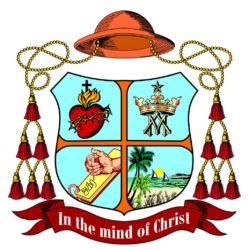History of the Diocese

The diocese of Kottar has parishes in the four revenue divisions (taluks) of Thovalai, Agasteeswaram,Kalkulam and Vilavancode in the civil district of Kanyakumari in Tamil Nadu.
Kanyakumari district has a unique position in the ecclesiastical map of India. Five Dioceses (Kottar, Thoothukudi and Thiruvananthapuram of the Latin rite, Thuckalay of Syro-Malabar rite and Marthandam of Syro-Malanakara rite) have their jurisdictions in this small district of 1672 square kilometres area.
The area under the present diocese of Kottar had known the Christian faith several centuries before the arrival of the Portuguese on the West Coast. Monuments discovered in Chinna Muttom near Kanniyakumari support it. The presence of St. Thomas Christians in Thiruvithancode, Kottar and other places in the district had also been attested by several missionaries under the Portuguese Padroado.
However with the arrival of the Portuguese missionaries, a small section of the local people known as Paravas became Christians in 1536-1537. Seven years after their conversion more than ten thousand fishermen known as ‘Mukkuvas” in the coastal villages from Poovar (now in the archdiocese of Thiruvananthapuram) to Pallam were baptized in 1544 by the greatest post-apostolic missionary of the Church, St. Francis Xavier. He was one among the first seven to take vows in the Society of Jesus founded by St. Ignatius of Loyola in 1534. The present Cathedral of St. Francis Xavier encompasses the church of St. Mary built by Francis Xavier.
With renewed efforts of the Sacred Congregation for the Propagation of the Faith (founded in 1622) Christian missionaries began to concentrate on and evangelize the interior parts of the area. Initially, attention was given to the evangelisation of the people of Vellala and Nair communities. Many from these communities embraced the Christian faith and prominent among them was the martyr of the diocese, Devasahayam (Lazar) whose previous name was Nilakanda Pillai.
He was born in the village of Nattalam in 1712 and was an official in the palace of King Marthanda Varma of Thiruvithancore. He was converted to Christian faith by the gentle efforts of a captured captain of the Dutch Navy, Eustachius De Lannoy who later became the Chief Admiral of the King’s army (In Malayalam he was known as Valia Capitan). Nilakanda Pillai was baptized as Lazar (Devasahayam) by hands of Rev. Fr. John Baptist Buttari, S. J., Parish priest of Vadakkankulam in 1745. The king tried in vain to entice him back to Hinduism. Then, the enraged king ordered him to be arrested and shot to death. After enduring torture for three years, Devasahayam was taken to Kattadimalai, Alravaimozhi, and shot to death on January 14, 1752. His mortal remains were interred in the church of St. Francis Xavier, which in turn became the Cathedral of the Diocese of Kottar in 1930.
The 18th century witnessed the rapid growth of Christianity in the interior parts of the area, following large scale conversion of the people of Nadar community. Vencode and Karenkadu were the centres of evangelization and conversion. With the creation of Verapoly- Varapuzha- Vicariate, the Portuguese Padroado system came to an end in this area except in the then seven parishes from Eraymanthura to Neerodi. In 1853, Kollam vicariate was established and was placed under the care of the Belgian Carmelite missionaries. With the establishment of the Hierarchy in India in 1886, Kollam became a diocese that extended from Mavelikara in the north to Kottar( Nagercoil) in the south, and Kottar became the centre of the southern part of Kollam diocese.
The Swiss-born, Carmelite Bishop Aloysius Maria Benziger was the architect of present diocese of Kottar. His saintly life, missionary zeal and great pastoral leadership helped the formation of many Catholic communities especially in the southern part of Kollam diocese. Knowing that education was important for the development of the people, Archbishop Benziger established schools in many of the coastal villages and founded St. Francis Teacher Institute at Assisi, Nagercoil, to train teachers for the schools. In all, he founded 112 schools in a short span of 25 years. Carmel High School and St. Joseph’s Higher Secondary School School, Nagercoil, remain living monuments to the foresight of this great visionary and missionary.
Archbishop Benziger was among the first to request the Vatican to beatify the Carmelite nun, St. Theresa of the Child Jesus of Little Flower and following her beatification he constructed the first church in the world at Kandanvilai (now in Kuzhithurai diocese) and blessed it on April 7,1924, and the second church was blessed on May 12, 1924 at Thoonkampara now in Neyyatinkara diocese. Accepting Pope Pius XI’s invitation, Archbishop Benziger assisted at her canonization ceremony on May 17, 1925.
Thanks to his recommendation the southern part of Kollam diocese was formed as a new diocese on May 26, 1930, with Fr. Lawrence Pereira as its first bishop, the third Indian to become a bishop in the Latin rite. Bishop Lawrence Pereira was no stranger to the new diocese since he had ministered in Vencode and Enayam areas. He had to toil hard to build the infrastructure of the new diocese from scratch. He was called to the eternal reward on January 5, 1938.
Though Tamil was the predominant language of the new diocese, it was part of Thiruvithancore and Cochin State with Malayalam as the state language. Keeping in mind the linguistic aspirations of the people of the diocese, the Vatican appointed the Tiruchirapalli native and Superior of Palayamkottai Jesuit Mission, Rev. Thomas Roch Agniswamy as succesor to Bishop Lawrence Pereira in 1939. In the reorganization of States in 1956, Kanyakumari district became part of Madras State now known as Tamil Nadu. In 1963, the diocese of Kottar was detached from the Metropolitan See of Verapoly and attached to the archdiocese of Madurai.
Evangelization activites received much impetus during the tenure of Bishop Agniswamy. A great number of parishes, mission stations and schools were established. His special interest in the promotion of local vocation resulted in the founding of St.Aloysius Minor Seminary for the diocese and Tamil Nadu Xavier Mission Home for the missions in North India.
Most Rev. Marianus Arckiasamy from Kumbakonam succeeded Bishop Agniswamy in 1971, and was committed to the implementing the reforms of the Second Vatican Council. Sixteen diocesan commissions were set up, specially focussing on Bible, Liturgy and Catechetics. Animation Centre, Pastoral and Youth Centers were established to spearhead pastoral activities. Formation of parish councils in more than fifty per cent of the parishes bear witness to his dedication. Conscious of the needs of the wider Church, he sent priests to serve in various capacities at national and international levels.
The communal riots that rocked Kanyakumari district in 1982, posed a great challenge to the diocese and to Bishop Arockiasamy. Premeditated and organized attacks at Mandaicadu Puthoor on Christians and church properties shattered the calm of the otherwise peaceful district. In all, ten Catholics lost their lives to police firings. Churches, convents and other religious places were vandalized and desecrated. People of Pallam parish had to flee for their lives. Coastal parishes were cut off from the main land and essential food supplies had to be carried through the sea. Bishop Arockiasamy and the Head of the Kundrakudi Hindu Mutt (Hermitage) and other religious leaders toured the affected areas to instill confidence in the people and peace returned to the riot-torn district. They founded” Thiruvarul Peravai”(Graceful Assembly) to foster communal and religious harmony. The Catholic Church in India and other parts of the world came to the help of the affected people. Bishop Arockiasamy continued to serve the diocese until his promotion as Archbishop of Madurai in 1987.
Fr. Leon A. Tharmaraj, who became the fourth bishop in 1989, was the first” son of the soil” to shepherd the diocese of Kottar. Bishop Leon faithfully carried forward the policies of his predecessor and went on further to make the diocese, truly the Church of the Christ’s lay faithful concentrating on Basic Christian (Ecclesial) Communities, Pastoral and Parish councils and lay leadership in the mission of the diocese. Consolidating the all-round growth initiated by his predecessor, Bishop Leon A. Tharmaraj outlined plans and programmes to make the parishes and the diocese self- sufficient and self- supporting.
The killer Tsunami waves that swept the coastal villages the day after Christmas in 2004 brought indescribable miseries to the lives and properties of thousands of Christians. More than 800 people lost their lives and thousands of houses, fishing boats and a few churches were damaged. Bishop Leon together with the entire diocese faced the challenge posed by the unprecedented loss and undertook to rebuild the lives and properties of the people. People from all walks of life irrespective of caste and creed joined in the valiant efforts of the diocese in rehabilitating the victims of the killer Tsunami. It is true the tragedies often bring the best in the human person and the Tsunami devastation witnessed the unprecedented outpouring of love and support from people of all walks of life in India and other parts of the world.” One touch of nature made the whole world kin”.
The diocese lost a true shepherd in the sudden death of Bishop Leon on January 16, 2007.
Bishop Peter Remigius, who hails from the diocese, was transferred from the diocese of Kumbakonam to Kottar and installed on August 24, 2007. To accelerate the mission work, he raised many mission centres into full-fledged parishes. People’s participation in the mission of the church of Kottar was given continued importance. Parish and Diocesan pastoral councils were strengthened.
The diocesan process for the beatification of the Servant of God, Devasahayam Pillai, that commenced in 1993, concluded on September 7, 2008, and the documents were forwarded to Rome on 24th September 2008. The Roman process started and on 18th March 2010 the Congregation certified the validity of the documents. The beatification of the servant of God Devasahayam Pillai took place on 2nd of December 2012.
From 95,000 people in 25 parishes ministered by 32 priests at the time of its formation in 1930, the vibrant Kottar Church, after 84 years of its life of ardent social and missionary work by the diocesan pastors along with the cooperation received from various dedicated religious priests, brothers, sisters and lay-faithful, witnessed its presence in 5,43,789 faithful in 181 parishes in 2014. The demands for spiritual welfare of the faithful, social as well as economic development, paved the way for approaching the Holy See to bifurcate the diocese of Kottar.
The erection of the new diocese under the name Kuzhithurai was announced by His Holiness, Pope Francis. Msgr. Jerome Dhas Varuvel S.D.B., a native priest of Kottar diocese became its first pastor. The consecration of the Msgr. Jerome Dhas Varuvel S.D.B. was held on 24th February 2015 . The new diocese set its journey of faith and development under the leadership of its new Pastor.
After the bifurcation, the diocese of Kottar began planning out its future in terms of pastoral, social, educational and economical development. This resulted in creating three parishes, namely, Vellamadam, Elankadai and Erachakulam.
The Holy Father Pope Francis appointed Fr. Nazarene Soosai, a priest of Kottar diocese, as the new Bishop of Kottar Diocese. Bishop Nazarene Soosai was consecrated on the 29th of June 2017 at the Bishop’s House campus. With his motto “In the mind of Christ”, the new Bishop made it known to the priests and the people of the diocese that the need was to build on the rich and value based foundation, evaluate our functioning with open minds and to work in participatory manner to realize God’s Kingdom.
As on date, the diocese of Kottar delights itself in the Lord with its 96 parishes, 34 sub-stations, 233 diocesan priests, 54 religious priests, 8 religious brothers , 489 sisters and 2,49,501 lay-faithful living in harmony with the brothers and sisters of other religions in the District of Kanniyakumari.
